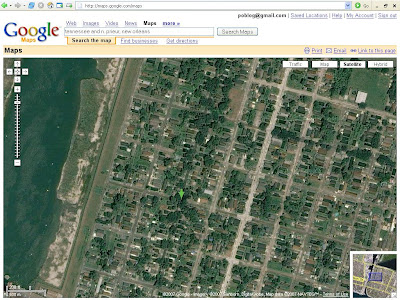Rep. Brad Miller, Chairman of the Investigations and Oversight Subcommittee of the House Science & Technology Committee, today asked Google Chairman Eric Schmidt to explain why Google had changed its satellite maps of the New Orleans region to pre-Hurricane Katrina images.Rep. Miller asked the Google chairman about the Google Conspiracy in a letter, which included these questions [pdf]:
“If current Google Maps satellite imagery is to be believed, Hurricane Katrina never struck New Orleans, there was never any flooding and thousands of people do not need to be living in trailers because their homes are still habitable,” Miller wrote.
1. What criteria were used by Google to determine that pre-Katrina satellite images would replace post Katrina images on the Google website? Who made that decision?Okay, the fact that a Congressional committee (albeit a House subcommittee) is investigating the Google Conspiracy is weird – and I love weird. But if the answer to questions #2 and #6 turns out to be yes, then things get even weirder – and I love weirder even more.
2. Was there any communication between Google employees and/or officials of the city of New Orleans or any other representative of the city before making this change?
***
5. In the article, Mr. Ohazama stated that he personally received no request for a change in the imagery, but “he added that Google gets many requests from users and governments to update and change its imagery.” How does Google deal with such requests, and how do such requests affect Google’s decision to update imagery?
6. Was Google contacted by the Federal Emergency Management Agency, the United States Geological Survey or any other entity of the federal government concerning any changes or revisions of the satellite imagers [sic] for the New Orleans region? If so, when were those requests received, and from whom?
Question #5, for what it’s worth, was first considered by Jeffrey at Library Chronicles, who also finds all this – in a word – weird.
On the local level, I can’t see Ray “My Google hits probably went up a million that week” Nagin asking Google to change the images. Ed Blakely, maybe. Anyone from the New Orleans Convention and Visitors Bureau, possibly.
But probably not. As I have said before, I don’t think there is a conspiracy here. There is only inaccuracy here. Pre-Katrina satellite images of the flooded areas of the city present an inaccurate map of New Orleans. You use the Satellite or Hybrid function to enhance your comprehension of the Google map you are viewing. Pre-Katrina satellite images distort the viewer’s comprehension by providing inaccurate information, such as multiple houses where there are no houses anymore.
However, to go back to the immediate post-Katrina satellite images would be equally as inaccurate. If I remember correctly, parts of the Lower 9th were flooded in those pics. New Orleans is no longer flooded. And the landscape of the Lower 9th, Lakeview, and Gentilly by the breaches has changed quite a bit.
If there is a conspiracy, though, I can’t wait to find out.
As an example of how inaccurate (and weird) it is to see pre-Katrina satellite pics, look at this July 2006 Metroblogging New Orleans post. The descriptions of what you should see are eerie compared to what you do see.
